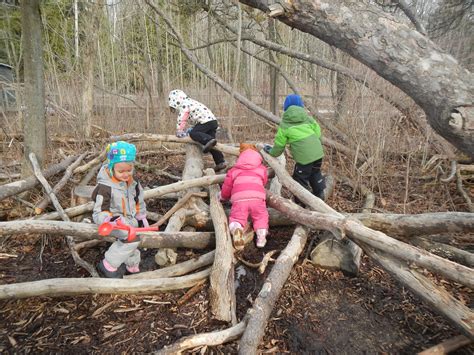Risky play is an important part of childhood development. It helps children develop a sense of risk awareness, problem solving skills, and physical strength and coordination. Outdoor activities such as climbing, jumping, and swinging provide children with a chance to take risks and develop necessary skills.
Risky play is defined as activities that involve physical risk and challenge a child’s existing abilities. It is not intended to cause physical harm, but it should be challenging enough that the child needs to think of ways to manage their risk in order to successfully complete the task. These activities can include climbing trees, balancing along a beam, and jumping from a height.
Risky play outdoors is also beneficial for the development of social skills. When children take part in risky play activities, they build trust among themselves and learn how to cooperate and work towards a common goal. This encourages children to take responsibility for their own actions and develop their self-confidence.
It is important to note that risky play should be supervised by an adult. It is also important to ensure that the environment and equipment used are safe and age-appropriate. Equipment should be checked regularly for signs of wear and tear, and any potential hazards should be removed.
Risky play can be a great way for children to explore their environment and build important skills. By encouraging and supervising risky play outdoors, parents and caregivers can help children develop their physical, social, and problem-solving skills in a safe and fun environment.
Exploring The Benefits And Dangers Of Outdoor Risky Play Activities
Kids naturally seek out risky outdoor play activities, such as climbing trees, playing on the monkey bars, and even swinging high on a trapeze. In recent years, risky play has become more popular as parents and educators recognize the potential benefits for physical and mental development.
Risky play offers a unique opportunity for children to push their boundaries, take risks, and grow. It provides an exciting environment where they can test their physical and mental limits without fear of judgement. This type of play also aids in developing gross motor skills, coordination, and balance. Additionally, it encourages social skills and problem-solving.
Despite the potential benefits of risky play, it is important to ensure that children are supervised and activities are properly managed. Without proper supervision, these activities can lead to serious injury. So, it’s important to be aware of the risks, and take the necessary precautions.
For instance, make sure that the equipment is in good condition and suitable for the activity. Also, ensure that the activity is age-appropriate and the area is free of hazards. Additionally, teach children about safety rules and encourage them to follow them.
Below is a table of some of the common outdoor risky play activities and the safety guidelines for each.
| Activity | Safety Guidelines |
|---|---|
| Climbing Trees | Ensure the tree is sturdy and free of hazards. Supervise children closely. |
| Playing on Monkey Bars | Check the equipment for any protruding bolts, sharp edges, or exposed nails. Monitor children closely. |
| Swinging on a Trapeze | Ensure the trapeze is securely fixed and inspected regularly. Monitor children closely. |
Exploring the benefits and dangers of outdoor risky play activities can be a fun and rewarding experience for both children and adults. However, it’s important to ensure that the activity is properly managed and that the necessary safety guidelines are followed.
Understanding The Benefits Of Outdoor Risky Play For Child Development
When it comes to a child’s development, outdoor play is essential. Outdoor play encourages physical activity which has many benefits for overall health. It also helps to create a sense of exploration, adventure and self-agency. But what about risky play?
Risky play is a type of outdoor play that involves activities that carry a risk of physical harm, such as climbing trees and jumping from high places. While dangerous in some cases, risky play can help to build self-confidence and resilience in children. It’s important to understand the benefits of risky play for children in order to make informed decisions about how and when to encourage it.
One of the main benefits of outdoor risky play is that it helps to build physical strength and coordination. Activities like climbing, jumping, and balancing all require strength and coordination, and help to build these skills over time. This is essential for a child’s development, and helps them to become more independent and adventurous.
Risky play also helps to build emotional resilience in children. Activities such as jumping from high places or climbing trees can be daunting for children, and involve overcoming fear. In the process of completing these activities, children learn to manage fear and develop resilience to cope with challenging situations.
Finally, risky play helps to build social skills. Activities such as playing tag or running in a group require children to interact with one another, helping to build social skills and relationships. Additionally, playing in a group environment helps children to learn cooperation and teamwork.
As with other types of outdoor play, it’s important to supervise children during risky play activities. It’s also important to make sure that the activities are age and skill-appropriate. Make sure that the environment is safe and that the activities are not too difficult or dangerous for the child. Additionally, it’s important to be aware of any risks associated with the activity, such as falling from a height, and take steps to manage these risks.
Understanding the benefits of outdoor risky play for child development is essential for parents and caregivers. It’s important to remember that, while risky play can be beneficial, it should always be done in a safe and supervised environment.
 Road Topic Tourism & Travel
Road Topic Tourism & Travel




